
Carbon Capture and Sequestration: Removing the Legal and Regulatory Barriers
Book details
Summary
Description
The United States produces over seventy percent of all its electricity from fossil fuels and nearly fifty percent from coal alone. Worldwide, forty-one percent of all electricity is generated from coal, making it the single most important fuel source for electricity generation, followed by natural gas. This means that an essential part of any portfolio for emissions reduction will be technology to capture carbon dioxide and permanently sequester it in suitable geologic formations. While many nations have incentivized development of CCS technology, large regulatory and legal barriers exist that have yet to be addressed. This book identifies current law and regulation that applies to geologic sequestration in the U.S., the regulatory needs to ensure that geologic sequestration is carried out safely and effectively, and barriers that current law and regulation present to timely deployment of CCS. The authors find the three most significant barriers to be: an ill-defined process to access pore space in deep saline formations; a piecemeal, procedural, and static permitting system; and the lack of a clear, responsible plan to address long-term liability associated with sequestered CO2. The book provides legislative options to remove these barriers and address the regulatory needs, and makes recommendations on the best options to encourage safe, effective deployment of CCS. The authors operationalize their recommendations in legislative language, which is of particular use to policymakers faced with the challenge of addressing climate change and energy.


We would LOVE it if you could help us and other readers by reviewing the book
Book review



